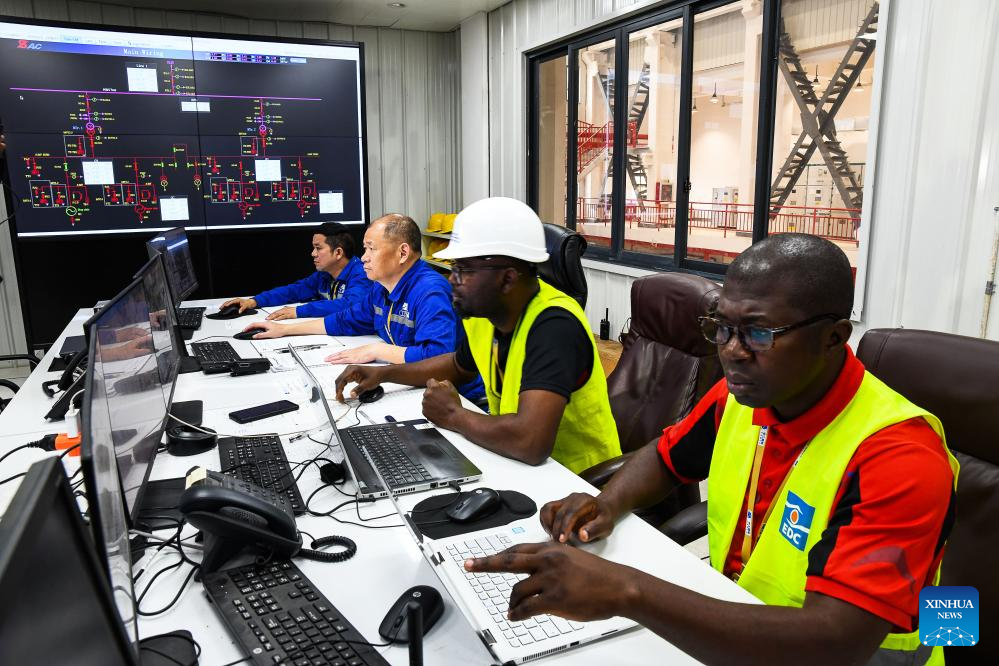
Chinese and Cameroonian staff members work at the control room of the Lom-Pangar Hydroelectric Plant in the East Region of Cameroon, Sept. 19, 2024.(Photo by Kepseu/Xinhua)
by Arison Tamfu, Wang Ze
YAOUNDE, Sept. 28 (Xinhua) -- Rising from Cameroon's East region at the confluence of the Lom and Pangar rivers of the Sanaga Basin, the Lom-Pangar Hydroelectric Plant stands as one of the nation's largest hydropower facilities.
When China CAMC Engineering Co., Ltd (CAMCE), a subsidiary of China National Machinery Industry Corporation (Sinomach), began constructing the megastructure, it aimed to increase hydropower generation capacity, reduce seasonal variability of water flow in the Sanaga Basin and increase access to electricity.
"The construction of the plant began in 2019, with the final unit officially handed over to the owner (Cameroon) on Sept. 17 of this year, marking the project's completion. Three units were delivered for commercial operation by the end of 2023, and with the completion of Unit 2, the last unit, the entire project is now fully operational," said You Yong, project director of the Lom-Pangar Hydroelectric Plant.
AN END TO ELECTRICITY SUPPLY CHALLENGES
Before the advent of the hydropower plant, the East region, Cameroon's breadbasket, which relied on electricity generated by a thermal power plant, was notorious for permanent power cuts.
The completion of the hydropower plant ushered in a golden era of regular electricity supply and marked a critical milestone in Cameroon's quest to increase electricity production, said Abba Alhadji Oumate, an official of the state-run Electricity Development Corporation.
With a capacity of 30 megawatts, the hydropower plant is playing a pivotal role in providing a reliable and sustainable source of clean energy to the local community.
"The production of the plant is more stable than the production of the thermal power plant," Oumate told Xinhua as he supervised workers in the control room of the hydropower plant.
The hydropower plant will "meet the electricity needs" of the region, declared You Yong, the project director of the Lom-Pangar Hydroelectric Plant.
Seated in his air-conditioned office in Bertoua, the chief town of the East region about some 90 km north of the Lom-Pangar plant, Jean Marie Dimbele Sodea, mayor of Bertoua, said the project has alleviated the energy crisis.
"Since the Lom Pangar power plant went operational, we no longer experience power cuts and voltage drops. These voltage drops destroyed devices in households and stores," Sodea said.
CATALYST FOR SOCIOECONOMIC EMPOWERMENT
Apart from stable power, the project has contributed to the growth of local industries, including food service, handicrafts, agro-processing and tourism, said Sodea. "For some time, industrialists have been arriving in the region. I am a very happy mayor because my city and my region will be industrialized," he said.
When night falls in Bertoua, Mathieu Tchuigwa, a businessman, switches on the light and it is business as usual. Tchuigwa, who owns shops in most parts of Cameroon, recently arrived from the commercial hub of Douala to open a branch of his business in Bertoua.
"I sell frozen products, if I don't have this energy, the products could get bad. I don't have any energy problems and it has been exactly five days since I connected to the electricity network," Tchuigwa said. "My shop is working well."
Oumate credited the project with providing invaluable job opportunities.
The unemployment rate in the breadbasket region has risen sharply amid the economic downturn in past years. When the dam project started, it employed 3,000 locals, which partly relieved the employment pressure in the region, Oumate said.
"As of today, we have over 80 locals working here," said Oumate, 38. "It is a project which has considerably improved the daily lives of Cameroonians."
EXAMPLE OF SOUTH-SOUTH COOPERATION
Didier Pamadjeli has been working for CAMCE for over three years. Before he was employed at the project, he used to work everywhere, barely making ends meet. The dam construction gave his life a leap. "We are the local workers and thanks to this work, we have started some businesses. Salaries are not bad and we have managed to build certain things like a house, and buy land," said the 32-year-old.
Following an agreement between Cameroon and CAMCE, Chinese colleagues are teaching Cameroonians about the operation and maintenance of the hydropower plant.
"The objective is that in two years, Cameroonians will be ready to take charge of the production plant after skills have been transferred," Oumate said. "Now Cameroonians have learned and continue to learn how to operate automatically, manually or semi-manual."
Co-financed by the African Development Bank and the government of Cameroon, the hydropower plant project highlights the vitality of South-South cooperation in infrastructure development, said James Ndimancho, international relations expert.
"This project is a model of collaboration in terms of South-South cooperation. It reflects the transformative power of unity and solidarity among developing nations and organizations," Ndimancho said. "China is joining hands with developing countries to work toward higher, broader and greater achievements in South-South cooperation. Only together can countries leverage multilateral support and realize shared prosperity." ■

An aerial drone photo taken on Sept. 18, 2024 shows a view of the Lom-Pangar Hydroelectric Plant and the dam in the East Region of Cameroon.(Photo by Kepseu/Xinhua)

An aerial drone photo taken on Sept. 18, 2024 shows a view of the Lom-Pangar Hydroelectric Plant in the East Region of Cameroon.(Photo by Kepseu/Xinhua)

You Yong, project director of the Lom-Pangar Hydroelectric Plant, poses for a photo inside the power plant in the East Region of Cameroon, Sept. 19, 2024.(Photo by Kepseu/Xinhua)
